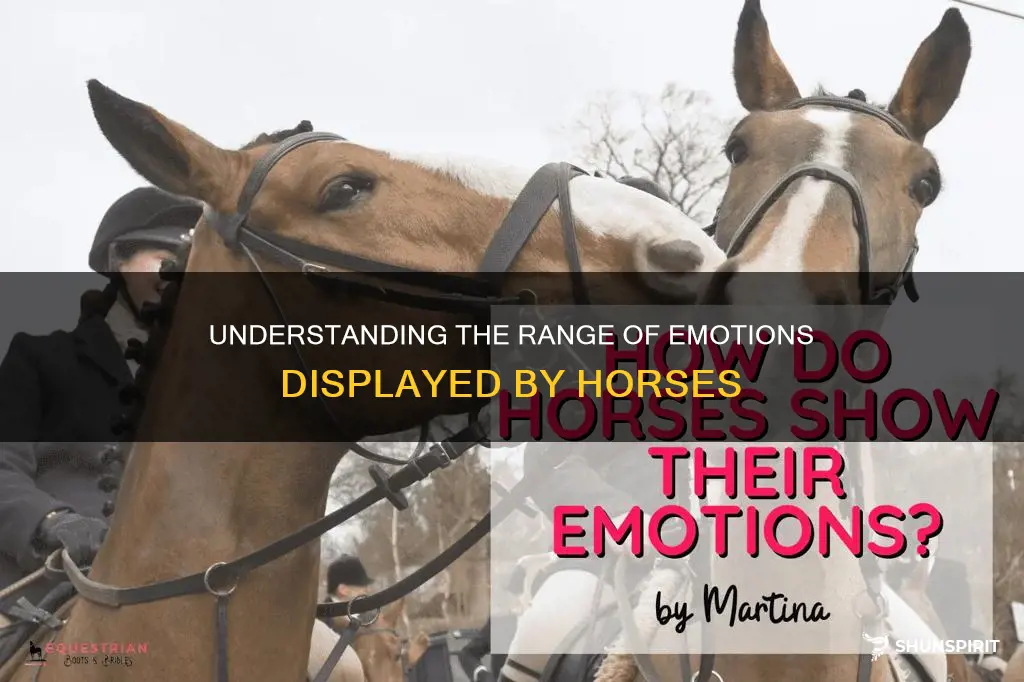
Horses, magnificent and majestic creatures, have captivated humans for centuries with their beauty and strength. But beyond their physical attributes lies a world of complex emotions and communicative abilities. Like humans, horses have the capacity to express a wide range of emotions, from joy and contentment to fear and anger. Understanding and interpreting these emotions is not only crucial for horse trainers and handlers but also for anyone who simply appreciates the intricacies of the equine world. In this article, we will explore how horses show different emotions and delve into the fascinating world of equine expressions. So saddle up and join us on this journey of emotional discovery in the horse kingdom!
| Characteristics | Values |
|---|---|
| Body language | Various |
| Facial Expressions | Ears, Eyes, Nostrils |
| Vocalizations | Neigh, Whinny, Snort, Squeal |
| Movement Patterns | Running, Trotting, Bucking |
| Tail and Mane movements | Swishing, Upright, Limp |
| Social interactions | Grooming, Nudging, Kicking |
| Eating and Drinking habits | Chewing, Gulping, Nibbling |
| Response to fear or danger | Flight, Freeze, Fight |
| Playfulness | Zooming, Jumps, Tail wags |
| Curiosity | Ears forward, Head tilt, Nosing objects |
What You'll Learn

Types of Emotions in Horses
Horses, just like humans, experience a wide range of emotions. Understanding these emotions is crucial for horse owners and handlers as it helps them build a stronger bond with their equine companions. In this blog post, we will explore the different types of emotions in horses, focusing on fear, happiness, surprise, and anger.
Fear is a primal emotion that all animals, including horses, experience. When horses feel fear, their bodies go into a fight-or-flight mode, preparing them to either confront the threat or escape from it. Common signs of fear in horses include wide-open eyes, raised head, trembling, spinning, or bolting. If your horse is displaying signs of fear, it's important to address the situation calmly and provide reassurance. Avoid punishing or forcing the horse as it can escalate their fear. Instead, create a safe environment and gradually expose the horse to the source of fear, using desensitization techniques to help them overcome their fear over time.
Happiness is a positive emotion that horses can experience in various situations. Signs of a happy horse include relaxed body posture, soft eyes, and a willingness to engage and interact. Horses are social animals, and their happiness is often associated with positive interactions with other horses or their human caretakers. Spending quality time with your horse, providing proper care and nutrition, and engaging in activities that they enjoy, such as grooming or going for a leisurely ride, can all contribute to their happiness. Additionally, providing your horse with a suitable environment, such as access to pasture or turnout time with other horses, can enhance their well-being and overall happiness.
Surprise is an emotion that horses might experience when faced with unexpected stimuli or situations. Their reactions to surprise can vary depending on the horse's temperament and individual learned responses. Some horses may become alert or tense, while others might startle and even jump or buck. As a horse owner or handler, it's important to remain calm and composed when your horse is surprised. Offering verbal reassurance and keeping a steady hand on the reins or lead rope can help your horse regain their composure. Gradual exposure to new or unexpected stimuli through desensitization training can also help horses develop resilience to surprises over time.
Anger is a complex emotion that is less frequently seen in horses but can still occur. Horses may become angry when they feel threatened, restrained, or when their personal space is invaded. Signs of anger in horses include pinned ears, a wrinkled muzzle, bared teeth, and aggressive behaviors like biting or kicking. It's crucial to handle angry horses with care and respect their boundaries. Avoid escalating the situation with aggressive or confrontational behavior, as this can heighten their anger. Instead, give the horse space and time to calm down and identify the underlying cause of their anger. Seeking assistance from a professional trainer or behaviorist can be beneficial in working through issues related to anger in horses.
Understanding and respecting the emotions of horses is essential for providing them with proper care and training. By recognizing and addressing their emotions of fear, happiness, surprise, and anger, horse owners and handlers can create a positive and harmonious relationship with their equine partners. Remember, patience, consistency, and a deep understanding of your horse's individual needs are key when it comes to managing their emotions effectively.
Tips for Practicing EQ Strategies to Enhance Emotional Intelligence
You may want to see also

Physical Signs of Emotions in Horses
Horses, like humans, have a complex range of emotions. Although they might not be able to communicate through words, they use various physical signs to convey their feelings. Understanding and interpreting these signs can be vital for horse owners, trainers, and riders. In this article, we will focus on some of the key physical signs of emotions in horses, including their ears position, tail movement, eye expressions, and facial expressions.
One of the most noticeable physical signs of a horse's emotional state is its ears position. The position of a horse's ears can provide valuable insights into how the horse is feeling. When a horse's ears are relaxed and facing forward, it generally indicates contentment and attentiveness. On the other hand, pinned-back or flat ears are often a sign of anger, aggression, fear, or pain. It is essential to pay close attention to changes in ear position, as it can help you understand and address any potential issues or discomfort that your horse may be experiencing.
Tail movement is another crucial indicator of a horse's emotional state. A horse will naturally carry its tail in a neutral position when it's feeling relaxed and calm. However, when a horse is excited, it may raise its tail slightly, while a tail held tightly against the body can be a sign of fear or discomfort. Pay attention to the rhythm, speed, and stiffness of your horse's tail movements, as they can provide valuable information about its current emotional state.
The eyes are often referred to as the windows to the soul, and it is no different when it comes to horses. The expressions in a horse's eyes can be highly revealing of its emotions. A horse with soft, relaxed eyes indicates contentment and relaxation. Conversely, when a horse's eyes appear wide open, with whites showing, it can indicate fear, pain, or stress. Additionally, a horse that is squinting or blinking excessively may be experiencing discomfort or irritation. By monitoring your horse's eye expressions, you can gain insight into its current emotions and well-being.
Facial expressions also play a significant role in understanding a horse's emotional state. Like humans, horses have a wide range of facial expressions that convey their feelings. A relaxed, soft facial expression with a slightly open mouth is generally a sign of contentment and relaxation. Tightened facial muscles, particularly around the mouth and eyes, can indicate discomfort, tension, or stress. Look for signs of tension, wrinkles, or clenched lips, as they can provide clues about your horse's emotional well-being.
In conclusion, understanding the physical signs of emotions in horses is vital for horse owners, trainers, and riders. By paying close attention to the position of their ears, tail movement, eye expressions, and facial expressions, you can gain valuable insights into your horse's emotions and well-being. Remember to always consider these signs in conjunction with other behavioral cues and consult with a veterinarian if you have concerns about your horse's emotional or physical health. By nurturing a deeper understanding of your horse's emotions, you can strengthen your bond and ensure their overall well-being.
The Emotional Toll of a Demanding Job: Understanding the Signs of Emotional Abuse in the Workplace
You may want to see also

Understanding Emotional Cues in Horses
Horses are highly intelligent and social animals, capable of expressing a wide range of emotions. As horse owners and riders, it is essential to understand and interpret their emotional cues, as this can help us better care for and communicate with these majestic creatures. In this article, we will explore the different ways horses express their emotions, with a focus on body language interpretation, vocalizations, behavioral changes, and their sensitivity to surroundings.
Body Language Interpretation:
One of the most effective ways to understand a horse's emotional state is through their body language. Horses use a combination of subtle cues and more overt signals to communicate with other horses and humans. Here are some key body language cues to look out for:
- Ears: Horses can position their ears in various ways to communicate their emotions. Alert, forward-facing ears indicate curiosity or interest, while pinned or backward-facing ears indicate anger or aggression. Relaxed, drooping ears often signify contentment or relaxation.
- Eyes: The eyes are the windows to a horse's soul. Wide, bright eyes generally indicate a relaxed and attentive state, whereas squinting or half-closed eyes can signify pain or discomfort.
- Tail: The position and movement of a horse's tail can convey a lot about their emotions. A relaxed tail held low indicates contentment, whereas a raised, stiff tail may indicate anxiety or tension.
- Posture: Horses can communicate their emotions through their overall posture. A relaxed horse will stand with a lowered head, while a tense or anxious horse may have a raised head and a stiff body.
Understanding these body language cues can help us gauge a horse's emotional well-being and respond appropriately.
Vocalizations:
Horses are not as vocal as some other animals, but they do make a variety of vocalizations to express their emotions. Here are some common vocalizations and their meanings:
- Neigh: This is a loud, high-pitched vocalization that horses use to communicate over long distances. A long, whinny-like neigh can indicate excitement or anticipation.
- Snort: Horses often snort when they are surprised or alert. It is a short, explosive sound made by blowing air through their noses and is generally a sign of heightened awareness.
- Nicker: A soft, low-pitched vocalization, the nicker is a friendly greeting or a call for attention. Horses often nicker when they see their favorite humans or when they anticipate food.
By paying attention to these vocalizations, horse owners can gain insights into their horse's emotional state and respond accordingly.
Behavioral Changes:
Horses, like humans, can experience changes in behavior when they are feeling a certain way. Some common behavioral changes indicative of emotional states include:
- Aggression: Horses may become aggressive when they feel threatened or stressed. This can manifest as biting, kicking, or charging at other horses or humans.
- Withdrawal: Horses that are feeling down or depressed may withdraw from social interactions and isolate themselves from the herd or their human companions.
- Excitement: Horses can become extremely energetic and spirited when they are excited or happy. They may gallop, buck, or exhibit playful behavior.
By observing and recognizing these behavioral changes, horse owners can adapt their interactions and provide appropriate support to their equine companions.
Sensitivity to Surroundings:
Horses are highly perceptive creatures and can be sensitive to their surroundings. Changes in their environment or external stimuli can significantly impact their emotional state. Some examples include:
- Loud Noises: Horses may become startled or anxious in response to loud noises such as fireworks or thunderstorms. It is essential to provide a calm, reassuring presence during such situations.
- New Surfaces or Objects: Horses can be wary of unfamiliar surfaces or objects in their environment. Slowly introducing new elements and using desensitization techniques can help them feel more comfortable and confident.
- Herd Dynamics: Horses are social creatures and rely on their herd for safety and companionship. Changes in the herd dynamics, such as the addition or removal of horses, can cause emotional stress and should be carefully managed.
Understanding a horse's sensitivity to their surroundings allows horse owners to create a safe and supportive environment that promotes their emotional well-being.
In conclusion, understanding emotional cues in horses is vital for horse owners and riders. By paying attention to their body language, vocalizations, behavioral changes, and sensitivity to surroundings, we can better understand and respond to their emotional needs. Developing this understanding can lead to a deeper bond and improved communication between humans and horses.
Unveiling the Emotional Depth of the Goddess Artemis
You may want to see also

Building a Strong Emotional Bond with Your Horse
First and foremost, spending quality time together is essential for building a strong emotional bond with your horse. Horses are social animals, and they thrive on companionship and interaction. By setting aside dedicated time each day to simply be with your horse, you are showing them that they are important and valued. This could involve activities such as hand grazing, taking leisurely walks, or even just sitting in their pasture and observing them as they go about their daily routines. The key is to be present and engaged during this time, allowing your horse to feel your undivided attention and focus.
Regular grooming and care are also crucial for building a strong emotional bond with your horse. Not only does grooming promote a healthy coat and skin, but it also provides an opportunity for you to connect with your horse on a physical and emotional level. During grooming sessions, take the time to talk softly to your horse, gently stroke their body, and be mindful of their reactions. This will not only help to keep your horse looking and feeling their best, but it will also deepen the trust and bond between you.
Positive reinforcement training is another powerful tool for building a strong emotional bond with your horse. Positive reinforcement involves rewarding desired behaviors with praise, treats, or a release of pressure. This approach focuses on encouraging and reinforcing the behaviors you want, rather than punishing or correcting unwanted behaviors. By utilizing this approach, you create a positive and rewarding training environment that fosters trust, respect, and a desire to please. Remember to keep training sessions short, fun, and rewarding, and be consistent in your cues and expectations.
Creating a safe and trusting environment is the final piece of the puzzle when it comes to building a strong emotional bond with your horse. Horses are prey animals, and they require a sense of security in their environment in order to bond with their human handlers. This means ensuring that their living quarters, pastures, and handling areas are well-maintained, clean, and free from hazards. Additionally, it's important to approach your horse with calmness and reassurance, as any displays of fear or anxiety can be sensed and may erode the trust you are trying to build.
In conclusion, building a strong emotional bond with your horse takes time and effort, but the rewards are well worth it. By spending quality time together, regularly grooming and caring for your horse, utilizing positive reinforcement training, and creating a safe and trusting environment, you can deepen your connection and create a partnership based on trust, respect, and mutual understanding. So go ahead, implement these strategies, and watch your bond with your horse flourish.
Understanding the Link Between Alcoholism and Emotional Abuse
You may want to see also
Frequently asked questions
Horses show happiness by various behaviors, such as nickering, whinnying, and neighing. They may also display a relaxed body posture, with their head and tail held high. Additionally, horses may exhibit playful behavior, such as rolling in the grass or engaging in social interactions with other horses.
Horses exhibit fear or anxiety through a number of behaviors. They may become restless, constantly moving or pawing the ground. Their ears may be pinned back and their eyes wide open, indicating a state of heightened alertness. Horses may also display more extreme behaviors, such as bolting or bucking, in response to fear or anxiety.
Horses might display aggression through various behaviors, including biting or kicking. They may also pin their ears back, bare their teeth, or engage in defensive posturing. Horses may also exhibit dominance behaviors, such as herding other horses or trying to establish their position in the hierarchy of a herd.
Horses can show signs of pain or discomfort through changes in behavior or body language. They may exhibit restlessness, such as constantly shifting their weight or pawing at the ground. Horses in pain may also display tense muscles, a hunched or arched back, or a strained facial expression. Additionally, they may show a reluctance to move or a decrease in appetite.







